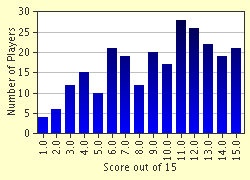Quiz Answer Key and Fun Facts
1. Let's start off your culinary adventure with a nice bowl of soup.
What is the main ingredient of "erwtensoep"?
2. On which holiday are Dutch doughnuts known as "oliebollen" traditionally served ?
3. Another holiday treat are "pepernoten" or "pepper nuts", a small hard cookie. Besides eating them, what else do the Dutch people do with them ?
4. A seafaring nation, the Netherlands has many traditional foods from the depths of the North Sea. Which seafood is their most popular, so much so that it is even sold by street vendors?
5. "Stroopwafels" aren't a waffle at all, but a traditional cookie in Holland. It is made of two "wafels" with a delicious filling in the middle. What would that filling be?
6. "Beschuiten", also known as "Dutch rusks" are a popular type of what?
7. If a Dutch housewife is preparing "kip" for a dinner entré, what is she cooking?
8. What is this traditional vegetable, known as "witloof" or chicory, called in North America?
9. The Dutch have many unusual and interesting things for breakfast, that are quite uncommon elsewhere. "Hagel" or "hagelslag" ("hail") is a traditional "addition" that is sprinkled on top of bread and butter. What is the most popular flavor of this specialty ?
10. Want to wet your whistle? This alcoholic beverage is probably the single most famous spirit in Holland.
11. "Plum Duff", a delicious Dutch dessert is more commonly known as 'Jan in de zak'. How does this funny name translate into English?
12. More a matter of cooking terminology than a food; the word "gevulde" is used in many names of recipes, as in "gevulde speculaas" (cookies) "gevulde eieren" (eggs) and "gevulde flensjes" (pancakes). What exactly does the word "gevulde" mean?
13. "More beans please!" O.K., wrong country with the quote, but in the Netherlands, "kapucijners" are almost a national bean - but what kind are they really? Chose from this list of beans:
14. Fancy a glass of Dutch eggnog? What would you be having?
15. Hope you have enjoyed your truly Dutch meal... Dessert might just be some of that Dutch eggnog, and now-a-days, a Dutchman or Dutchwoman might want to put some "boerenjongens" in the bottom of your bowl before you eat it. What do you think "boerenjongens" are?
Source: Author
poppetje
This quiz was reviewed by FunTrivia editor
bloomsby before going online.
Any errors found in FunTrivia content are routinely corrected through our feedback system.


